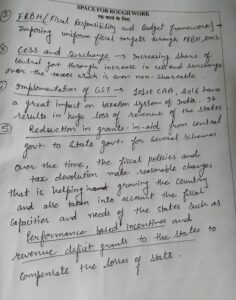The word Secular was added to the Preamble of Indian constitution through an amendment to the Constitution. Was Indian Constitution Secular as on 26 November, 1949, Enumerate.
The Constitution of India is quasi – federal where it has some federal characteristics and some unitary characteristics. In theory, it establishes a federal system by dividing powers between the central and state governments through three distinct lists in the Seventh Schedule: the three lists namelRead more
The Constitution of India is quasi – federal where it has some federal characteristics and some unitary characteristics. In theory, it establishes a federal system by dividing powers between the central and state governments through three distinct lists in the Seventh Schedule: the three lists namely the Union List, Stated List and Concurrent list. From this division, there seems to be a clear cuts federal structure guaranteeing that states are sovereign with regard to some issues. But in fact it can be seen that the constitution of Indian is has a tilt towards the unitary form. Some of these characteristic include; The Concurrent List that allows the central government to override the state laws, Article 356 giving the central government the power to dismiss state governments, Financial control and emergency powers are centralized, all of which show the unitary nature. Further, constitution provides the single constitution single citizenship and the power of the Parliament to redraw state boundaries to illustrate central dominance. Another feature depicts the structural aspect of unitary state that is the central government exercise of prerogatives in sensitive sectors such as defense, foreign affair, and communication, besides the Governor, being the representative of President in the state. Hence having federal structure at the constitution level the political system of India can be defined predominantly unitary due to centralisation of powers with the central government.
See less


Secularism can be defined as a social order where religion is neither actively promoted nor criticized. The western concept of secularism is based on the idea of mutual exclusion i.e both religion and state must stay away from each other. The Indian concept of secularism is different as we follow thRead more
Secularism can be defined as a social order where religion is neither actively promoted nor criticized. The western concept of secularism is based on the idea of mutual exclusion i.e both religion and state must stay away from each other. The Indian concept of secularism is different as we follow the idea of Principled Distance i.e there is no strict boundary between state and religion and they are not divided into water tight compartments as they share porous borders boundaries.
Originally the Indian constitution did not mention the word Secularism. It was added by the 42nd Amendment in 1976 but it does not mean that The Indian constitution was not secular on 26th November 1949 when the constitution was adopted. Through various articles Indian constitution has ascertained that India is a secular nation.
Indian secularism is based on the following ideologies:
Nehruvian – State should not have any religion and state should not discriminate anyone on the basis of religion. Article 15 and 27.
Gandhian – “Sarv Dharm Sambhav” i.e. all religions coexist. Religions should be treated equally and rights to practice ones religion. Article 25 and 14.
Dr. B.R. Ambedkar – Minorities right to religion. Article 29, 30 and 17.
Fundamental rights:
Article 14: Equality before law (irrespective of religion)
Article 15: State shall not discriminate on the basis of religion.
Article 25 – 28: Ensure freedom of religion to all.
Secularism forms the basics structures of the constitution. The Indian Union is not completely identified with a particular religion also it is not adverse to the use of religious symbols. Every citizen is equally entitled to the freedom of conscious and right to religion to freely profess, practice and propagate the religion of their own choice. Thus it would be correct to say that Indian constitution was secular even on 26 November 1949 before the word secularism was added in the Indian constitution by the 42nd constitutional amendment of 1976.
See less